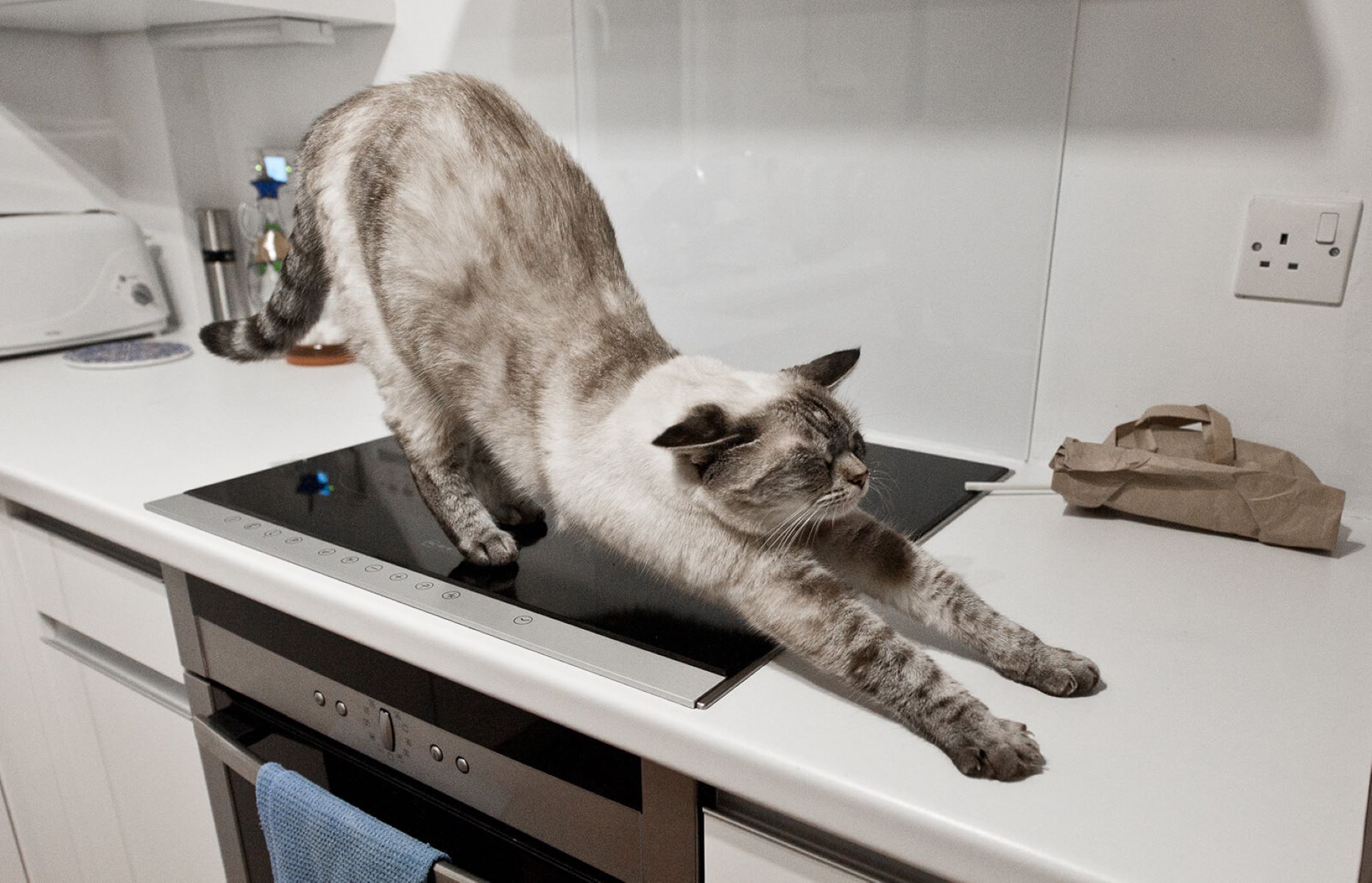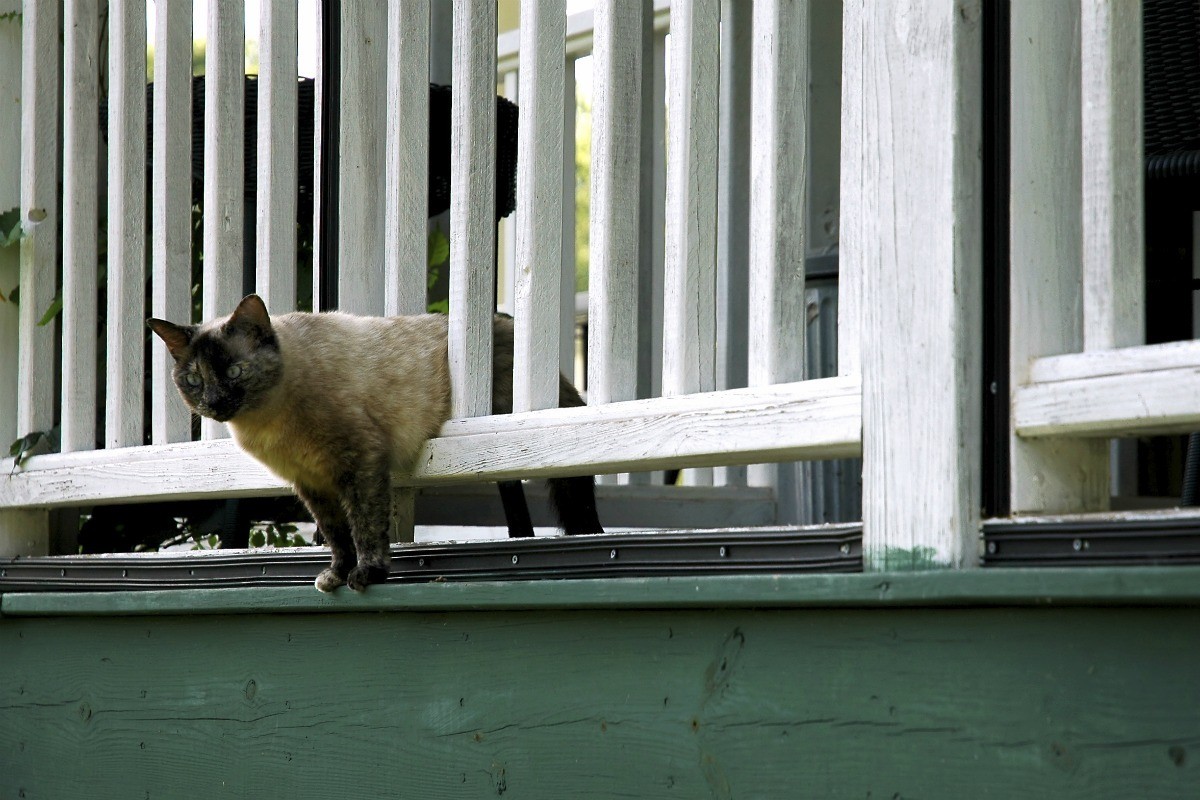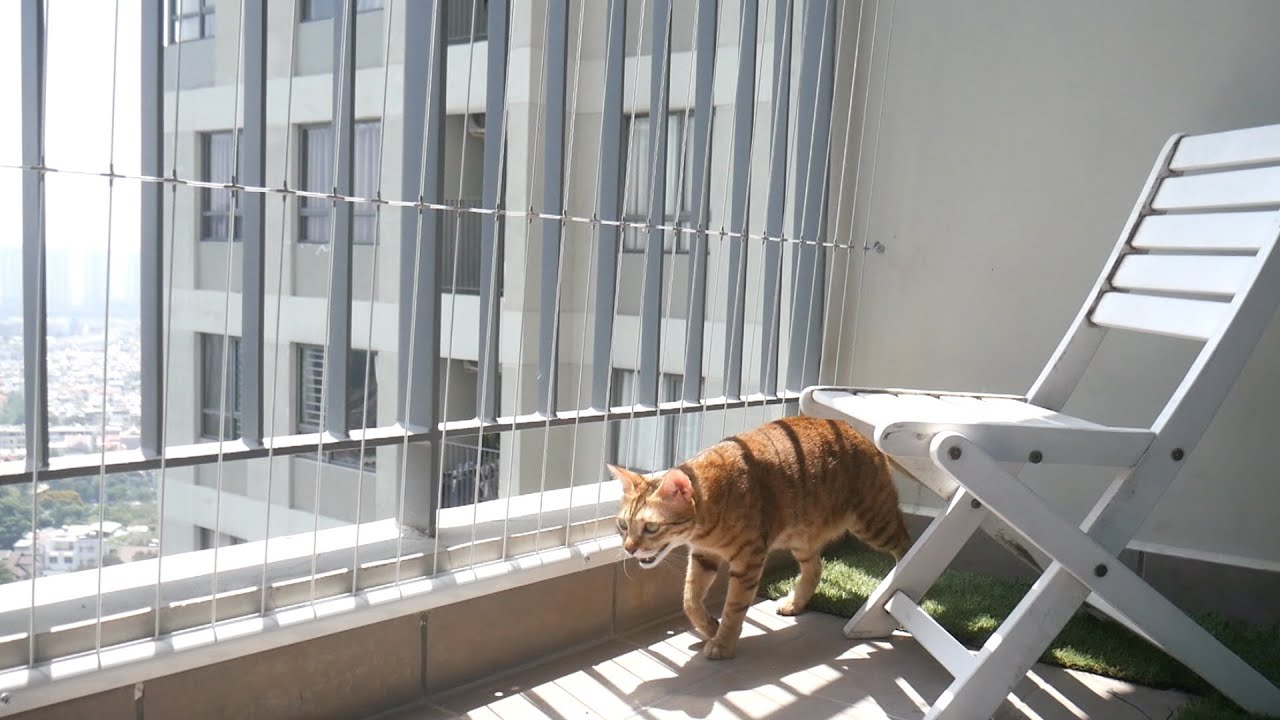

Articles
How To Keep Cats Off Countertops
Modified: January 23, 2024
Discover effective strategies and solutions in these informative articles on how to keep cats off countertops. Say goodbye to unwanted feline companions in your kitchen.
(Many of the links in this article redirect to a specific reviewed product. Your purchase of these products through affiliate links helps to generate commission for Storables.com, at no extra cost. Learn more)
Introduction
Having a cat can bring joy and companionship to your life, but it’s no secret that they can also be mischievous and curious creatures. One common problem many cat owners face is the constant battle of keeping their furry friends off the countertops. While it may seem harmless to let your cat explore the kitchen counters, it can actually pose several risks. From hygiene concerns to potential accidents, it’s important to understand why cats get on countertops and how to effectively keep them off.
There are several reasons why cats are drawn to countertops. First and foremost, cats are natural climbers. They have a strong instinctual curiosity and love to explore elevated surfaces. Countertops provide them with a vantage point to observe their surroundings and satisfy their instinctual desire to be in high places.
Another reason why cats get on countertops is the association with food. Cats are highly motivated by food, and they may be enticed by the smells emanating from the kitchen. If they have successfully found food on the countertops before, they will be motivated to repeat the behavior.
While cats getting on countertops may seem harmless, it’s important to address this behavior for several reasons. Firstly, it can pose a hygiene concern. Kitchen countertops are where we prepare food, and having a cat walking around on them can introduce germs and bacteria. Secondly, there’s the risk of food contamination. Cats may not just walk on the countertops, but also try to sample the food left there. This can lead to cross-contamination and potential health issues.
Furthermore, there’s the risk of accidents occurring. Cats can knock over items on the countertop, such as glasses or knives. This can not only result in damage to your kitchenware but also pose a danger to your cat if they get injured in the process. By keeping your cat off the countertops, you can create a safer environment for both you and your feline companion.
In the next sections, we will explore various strategies and techniques to help you keep your cat off the countertops. From creating a cat-friendly environment to using deterrents and behavioral training, we will cover a range of approaches that are effective in curbing this behavior. With consistency and patience, you can establish a routine that encourages your cat to stay off the countertops and enjoy a harmonious relationship in your kitchen.
Key Takeaways:
- Understanding the reasons behind your cat’s countertop behavior, such as their natural climbing instincts and association with food, is crucial for tailoring effective strategies to keep them off the countertops and maintain a hygienic kitchen environment.
- Consistency, positive reinforcement, and creating alternative spaces for your cat to climb and explore are essential for successfully training them to stay off countertops, promoting a safe and harmonious living space for both you and your feline companion.
Read more: How To Keep Cat Off Furniture
Understanding why cats get on countertops
Before implementing strategies to keep cats off countertops, it’s essential to understand why they are drawn to these elevated surfaces. As natural climbers, cats have an innate instinct to explore high places, and countertops provide them with an elevated view of their surroundings. This vantage point allows them to observe their environment, feel secure, and assert their dominance.
Another factor that drives cats to the countertops is their association with food. Kitchen countertops often carry the tantalizing scent of delicious meals, which can be irresistible to a food-motivated cat. Even the remnants of a meal can be enticing enough for them to attempt to scavenge for scraps.
Additionally, countertops can provide cats with a sense of comfort and security. In many households, countertops are located near windows, offering cats a prime spot to bask in the warmth of the sun and watch the world outside. Cats may also seek out countertops as a way to escape children, other pets, or commotion in the house, providing them with a quiet and secluded area to retreat to.
It’s important to note that cats are creatures of habit. If they have successfully found food or received attention while on the countertops in the past, they will be motivated to repeat the behavior. Cats are intelligent animals and quickly learn which behaviors result in positive outcomes, reinforcing their belief that getting on countertops is a rewarding activity.
Understanding the reasons behind your cat’s countertop behavior can help you tailor your approach to keep them off. By addressing their need for elevation, providing alternate spaces, and eliminating any reinforcement or rewards associated with countertops, you can effectively redirect their behavior and discourage them from using kitchen counters as their personal domain.
In the following sections, we will discuss various strategies to create an environment that deters cats from getting on countertops. By implementing these techniques, you can ensure a sanitary and safe food preparation area while maintaining a harmonious relationship with your feline companion.
The importance of keeping cats off countertops
Keeping your cats off countertops is more than just a matter of convenience; it is essential for maintaining a clean and safe environment in your kitchen. Let’s explore the importance of this practice:
1. Hygiene and food safety: Kitchen countertops are where we prepare and handle food. Allowing cats on these surfaces can introduce germs, bacteria, and hair onto the areas where we eat and cook. Cats may walk across the countertops with dirty paws, potentially contaminating the food preparation area. By keeping cats off countertops, you can ensure proper hygiene and reduce the risk of foodborne illnesses.
2. Avoiding accidental spills and breakages: Cats are known for their curiosity and can easily knock over items on the countertop. This puts both your kitchenware and your cat at risk. Breaking glasses, plates, or utensils can not only result in costly damages but also pose a danger to your cat if they accidentally ingest shards of glass or get injured by sharp objects. By keeping your cats off countertops, you can minimize the chance of accidents occurring.
3. Preventing access to unsafe items: Countertops often contain items that can be harmful to cats. This includes toxic cleaning products, hot appliances, and sharp objects. Cats may accidentally come into contact with these hazardous materials and put themselves at risk of injury or poisoning. Keeping countertops off-limits ensures that cats are not exposed to potential harm.
4. Preserving the enjoyment of mealtime: Cats are notorious for begging and sneaking food from the countertops during mealtime. Not only can this disrupt your dining experience, but it can also lead to unhealthy habits and weight gain for your feline friend. By preventing access to the countertops, you can maintain a peaceful and enjoyable meal without having to constantly monitor your cat’s behavior.
5. Establishing boundaries and reinforcing training: Teaching your cats to stay off countertops helps establish boundaries and reinforces obedience training. By consistently redirecting them to appropriate scratching posts or designated spaces, you can encourage positive behavior and strengthen the bond between you and your cat.
Ultimately, keeping cats off countertops is about creating a clean, safe, and harmonious environment for both you and your feline companion. By implementing strategies to deter them from these surfaces, you can promote a healthier lifestyle and minimize potential risks. In the next sections, we will explore various methods and techniques to achieve this goal effectively.
Creating an environment to deter cats
Creating an environment that deters cats from getting on countertops is an important step in keeping them off these surfaces. By making countertops less appealing and providing alternative spaces, you can effectively redirect your cat’s behavior. Here are some strategies to accomplish this:
1. Clear off the countertops: Remove any items from the countertops that may be attracting your cat, such as food bowls, food remnants, or food packaging. Clearing off the countertops eliminates the association between the surface and food, making it less enticing for your cat to jump up.
2. Use double-sided tape or aluminum foil: Cats dislike sticky surfaces and the sound and feel of aluminum foil. Placing double-sided tape or aluminum foil on the edges or surfaces of the countertops can discourage your cat from jumping up. The uncomfortable texture and sound will make them think twice before attempting to access the countertops.
3. Install motion-activated deterrents: Motion-activated deterrents, such as air canisters or ultrasonic devices, can startle cats when they jump onto the countertops. These devices emit a harmless burst of air or a high-pitched sound, creating a negative association with the countertops and making your cat think twice before venturing up again.
4. Create physical barriers: Putting up physical barriers, such as baby gates or strategically placed obstacles, can prevent cats from easily accessing and jumping onto the countertops. Block off access to the kitchen or install barriers near countertop edges to deter your cat from attempting to reach them.
5. Optimize your cat’s environment: Cats need appropriate vertical spaces to satisfy their climbing instincts. Provide your cat with alternative elevated areas such as cat trees, shelves, or window perches. By offering these alternatives, you give your cat an acceptable and rewarding space to explore and observe their surroundings, reducing their incentive to jump onto countertops.
6. Ensure entertainment and mental stimulation: Boredom can contribute to cats seeking out countertops as a form of entertainment. Providing interactive toys, puzzle feeders, and regular play sessions can help keep your cat engaged and mentally stimulated, reducing their desire to explore forbidden areas.
7. Utilize scent deterrents: Cats dislike certain smells, such as citrus or lavender. Spraying these scents around the countertop edges or using citrus-scented cleaners can discourage your cat from approaching the area. Just be sure to avoid any harmful or toxic substances that may be dangerous to your cat.
Implementing these strategies can help create an environment that deters cats from getting on countertops. However, it’s important to remember that consistency and patience are key. It may take some time for your cat to adjust to the changes and understand the new boundaries. By providing alternative spaces, removing incentives, and making the countertops less appealing, you can effectively redirect your cat’s behavior and maintain a harmonious kitchen environment.
Providing alternative spaces for cats
One effective way to keep cats off countertops is to provide them with alternative spaces where they can climb, observe, and satisfy their natural instincts. By offering appealing and designated areas for your cat, you can redirect their attention away from the countertops. Here are some strategies for providing alternative spaces:
1. Cat trees and towers: Cat trees and towers are excellent options for creating vertical spaces that cats can climb and explore. Look for sturdy structures with multiple levels, scratching posts, and hiding spots. Place the cat tree near a window or in a location where your cat can comfortably observe their surroundings.
2. Window perches: Cats love to bask in the sunlight and watch the world outside. Install window perches or secure shelves near windows to create comfortable spots for your cat to enjoy the view. Adding a soft cushion or blanket to the perch can make it even more inviting.
3. Wall-mounted shelves and walkways: Utilize wall-mounted shelves and walkways to create a vertical playground for your cat. These floating shelves provide excellent climbing opportunities and allow your cat to navigate around the room while staying off the countertops. Ensure the shelves are securely installed to support your cat’s weight.
4. Enclosed spaces: Cats love cozy, enclosed spaces where they can retreat and feel safe. Provide your cat with a dedicated bed, igloo, or a covered cat carrier with a soft blanket. Place it in a quiet corner of the room or near your own bed to create a comforting space for your cat to rest and relax.
5. Scratching posts and pads: Cats have a natural instinct to scratch, and providing appropriate scratching options is essential. Place scratching posts or pads near the areas where your cat tends to approach the countertops. This not only redirects their attention but also helps to keep their claws from damaging furniture.
6. Cat tunnels and hiding spots: Set up tunnels and hiding spots to add an element of fun and play for your cat. Consider using cardboard boxes, fabric tunnels, or dedicated cat tunnels that offer spaces for them to explore and engage in interactive play.
7. Interactive toys and puzzles: Engage your cat’s mind and provide entertainment with interactive toys and puzzles. These toys stimulate their natural hunting instincts and keep them engaged. Rotate the toys regularly to keep them fresh and exciting for your cat.
By providing these alternative spaces, you give your cat outlets to fulfill their climbing instincts, explore new environments, and fulfill their natural desires. Remember to observe your cat’s preferences and adjust the setup accordingly. Every cat is unique, and offering a variety of options will ensure their needs are met, ultimately keeping them off the countertops and promoting a harmonious living environment.
Place double-sided tape or aluminum foil on the countertops to deter cats from jumping up. They dislike the sticky feeling on their paws.
Read more: How To Keep Cats Off Of Outdoor Furniture
Using deterrents to prevent cats from getting on countertops
When it comes to keeping cats off countertops, using deterrents can be an effective strategy. Deterrents create an unpleasant or dissuasive experience for your cat, discouraging them from jumping onto the countertops. Here are some common deterrents and techniques that you can employ:
1. Citrus or bitter sprays: Cats have a strong aversion to citrus smells and bitter tastes. Spraying citrus-scented sprays or bitter-tasting substances around the edges of the countertops can discourage your cat from approaching. Be sure to use cat-safe products or natural alternatives to avoid any harmful effects.
2. Sticky tape or mats: Cats dislike the sensation of sticky surfaces on their paws. Placing double-sided sticky tape or specially designed sticky mats on the countertops can discourage cats from jumping up. The discomfort of the sticky surface will make them think twice before trying to access the countertops.
3. Motion-activated deterrents: Motion-activated deterrents, such as air canisters or ultrasonic devices, can startle cats when they approach the countertops. These devices emit a burst of air or high-pitched sound, which cats find unpleasant. With repeated exposure, cats will learn to associate the countertops with the unpleasant experience, deterring them from attempting to jump up.
4. Aluminum foil: Cats dislike the texture and sound of aluminum foil. Placing sheets of aluminum foil on countertops can create an uncomfortable experience for your cat, making them less likely to jump up. However, be aware that some cats may become accustomed to the foil over time, so it may not be a foolproof solution on its own.
5. Scat mats or pet-friendly mats: Scat mats or pet-friendly mats deliver a small static shock when your cat touches them. The harmless static shock creates a negative association with the countertops, deterring cats from jumping up. These mats are available in various sizes and can be placed strategically on countertops or near their edges.
6. Noise deterrents: Cats are highly sensitive to sudden loud noises. Setting up noise deterrents, such as a motion-activated sound alarm or using a can filled with coins that rattles when disturbed, can startle cats and discourage them from approaching the countertops. It’s important to choose gentle sounds that do not cause fear or distress to your cat.
7. Water spray bottles: A gentle spray of water can be an effective deterrent for some cats. When you catch your cat attempting to jump onto the countertops, give them a quick spritz of water. The sudden spray will startle them and create a negative association with the behavior. However, it’s important to note that this approach may not be suitable for all cats, as some may develop fear or anxiety towards water.
Remember, it’s important to use deterrents as a temporary measure while you train your cat to stay off the countertops. By consistently redirecting their behavior and providing alternative spaces and rewards, you can encourage them to make the right choices. Combining deterrents with positive reinforcement will help your cat understand that staying off the countertops is more beneficial and rewarding.
Keep in mind that every cat is unique, and some deterrents may be more effective than others. Observe your cat’s reactions and adjust your approach accordingly. With patience, consistency, and a combination of deterrents and training, you can successfully keep your cat off the countertops and create a more harmonious living space.
Behavioral training to keep cats off countertops
In addition to using deterrents, behavioral training is an important aspect of teaching your cat to stay off countertops. Training helps establish boundaries, reinforces positive behavior, and strengthens the bond between you and your furry friend. Here are some effective training techniques to consider:
1. Positive reinforcement: Positive reinforcement is a powerful training method that rewards desired behavior. Whenever you catch your cat staying off countertops or using their designated spaces, praise them and offer treats or their favorite toys. By associating these rewards with good behavior, your cat will learn that staying off the countertops is beneficial and more rewarding.
2. Redirecting and distraction: When you see your cat attempting to jump onto the countertops, gently redirect their attention to an alternative space or a toy. Encourage them to use scratching posts, cat trees, or interactive toys and provide positive reinforcement when they engage in these behaviors instead. Consistently redirecting their behavior helps them understand what is expected of them and promotes the use of appropriate spaces.
3. Clicker training: Clicker training is a popular method that uses a clicker as a marker for desired behavior. Whenever your cat chooses to stay off the countertops, click the clicker and immediately reward them with treats or praise. Over time, your cat will associate the clicker sound with the positive reinforcement, reinforcing the behavior you want.
4. Use negative markers: Negative markers, such as a firm “no” or a gentle clap, can help discourage your cat from jumping onto the countertops. When they approach the forbidden surface, use the negative marker to interrupt their behavior. Pair this with positive redirection towards their designated spaces or alternative surfaces to reinforce the desired behavior and discourage countertop exploration.
5. Time outs: If your cat persistently ignores your training efforts and continues to jump on the countertops, you can use time outs as a consequence. When they engage in the unwanted behavior, carefully and calmly pick them up and place them in a quiet room or an enclosed space. This temporary isolation teaches them that jumping onto countertops leads to a loss of freedom or attention, encouraging them to seek out acceptable spaces instead.
6. Consistency and repetition: Consistency is critical when training your cat. Enforce the same rules and utilize the same training techniques consistently to avoid confusion. Reinforce the desired behavior every time you catch your cat staying off the countertops, and be patient as it may take time for them to understand and change their habits.
Remember to never resort to physical punishment or shouting. These actions can damage your relationship with your cat and may lead to fear or aggression. Training should always focus on positive reinforcement and building trust. With patience, consistency, and positive reinforcement, you can effectively train your cat to stay off countertops and redirect their behavior to more appropriate areas.
Ensuring consistency and reinforcement
To successfully keep your cat off countertops, consistency and reinforcement are key. By following these practices, you can establish clear boundaries and encourage positive behavior in your feline companion:
1. Establish household rules: Set clear and consistent rules regarding countertop access. Make sure all family members are aware of these rules and actively participate in enforcing them. Consistency throughout the household is crucial for your cat to understand and follow the established boundaries.
2. Remove rewards and incentives: Ensure that there are no rewards or positive reinforcements associated with countertop exploration. Remove any food, crumbs, or easily accessible items that may entice your cat. By eliminating these rewards, you limit their motivation to jump on countertops.
3. Reinforce the use of alternative spaces: Every time your cat uses their designated spaces, such as scratching posts or cat trees, provide positive reinforcement immediately. Praise them, offer treats, or engage in play to reward their good behavior. This reinforces the association between using the designated spaces and receiving rewards, encouraging your cat to continue using them instead of the countertops.
4. Be patient and persistent: Changing your cat’s behavior takes time and patience. Resist the temptation to give in or allow occasional countertop access, as it can confuse your cat and undermine your training efforts. By staying persistent and consistent, you increase the chances of your cat understanding and respecting the boundaries you’ve set.
5. Monitor and interrupt unwanted behavior: Keep a close eye on your cat’s behavior and take immediate action when they attempt to jump on countertops. Use gentle vocal cues or clapping hands to interrupt their behavior. Redirect them to an alternative space and reward them when they comply. Consistently monitoring and interrupting unwanted behavior reinforces the message that countertops are off-limits while redirecting them to appropriate areas.
6. Make countertops unappealing: Continuously implement deterrents, such as sticky tape, aluminum foil, or scent repellents, to keep countertops unattractive to your cat. Over time, the consistent association between these deterrents and the countertops will reinforce the idea that the surface is undesirable, further discouraging their attempts to access it.
7. Avoid punishment: It is crucial to remember that punishment should never be used as a training method. Physical punishment or shouting can damage the trust between you and your cat, leading to fear, stress, and potential aggression. Stick to positive reinforcement techniques, and provide a safe and loving environment for your feline companion.
Consistency and reinforcement are key components of successful training. By consistently enforcing household rules, removing rewards, redirecting behavior to alternative spaces, and providing positive reinforcement, you can effectively train your cat to stay off countertops. Remember to be patient, persistent, and always prioritize the well-being of your furry friend throughout the training process.
Conclusion
Keeping cats off countertops is essential for maintaining a clean, safe, and harmonious living environment. Understanding why cats get on countertops and the potential risks associated with this behavior is the first step towards finding effective solutions.
Creating an environment that deters cats from accessing countertops is crucial. Clearing off countertops, using deterrents like sticky tape or sprays, and providing alternative spaces such as cat trees or window perches can redirect your cat’s attention and fulfill their natural climbing instincts. Additionally, implementing behavioral training techniques, such as positive reinforcement and consistency, helps establish boundaries and reinforce positive behaviors.
Using deterrents, such as citrus sprays or motion-activated devices, can discourage cats from jumping onto countertops. However, it’s important to remember that deterrence should be paired with positive reinforcement and training to achieve long-term success.
Consistency and reinforcement are key factors in training your cat to stay off countertops. By establishing household rules, removing rewards, and consistently redirecting your cat’s behavior to alternative spaces, you can encourage them to make the right choices and respect the boundaries you’ve set.
Remember to be patient, persistent, and avoid resorting to punishment. Building a positive and trusting relationship with your cat is essential for effective training and long-term behavior change.
By taking the necessary steps to keep your cat off countertops, you can create a sanitary and safe food preparation area while fostering a harmonious coexistence with your feline companion.
Frequently Asked Questions about How To Keep Cats Off Countertops
Was this page helpful?
At Storables.com, we guarantee accurate and reliable information. Our content, validated by Expert Board Contributors, is crafted following stringent Editorial Policies. We're committed to providing you with well-researched, expert-backed insights for all your informational needs.















0 thoughts on “How To Keep Cats Off Countertops”